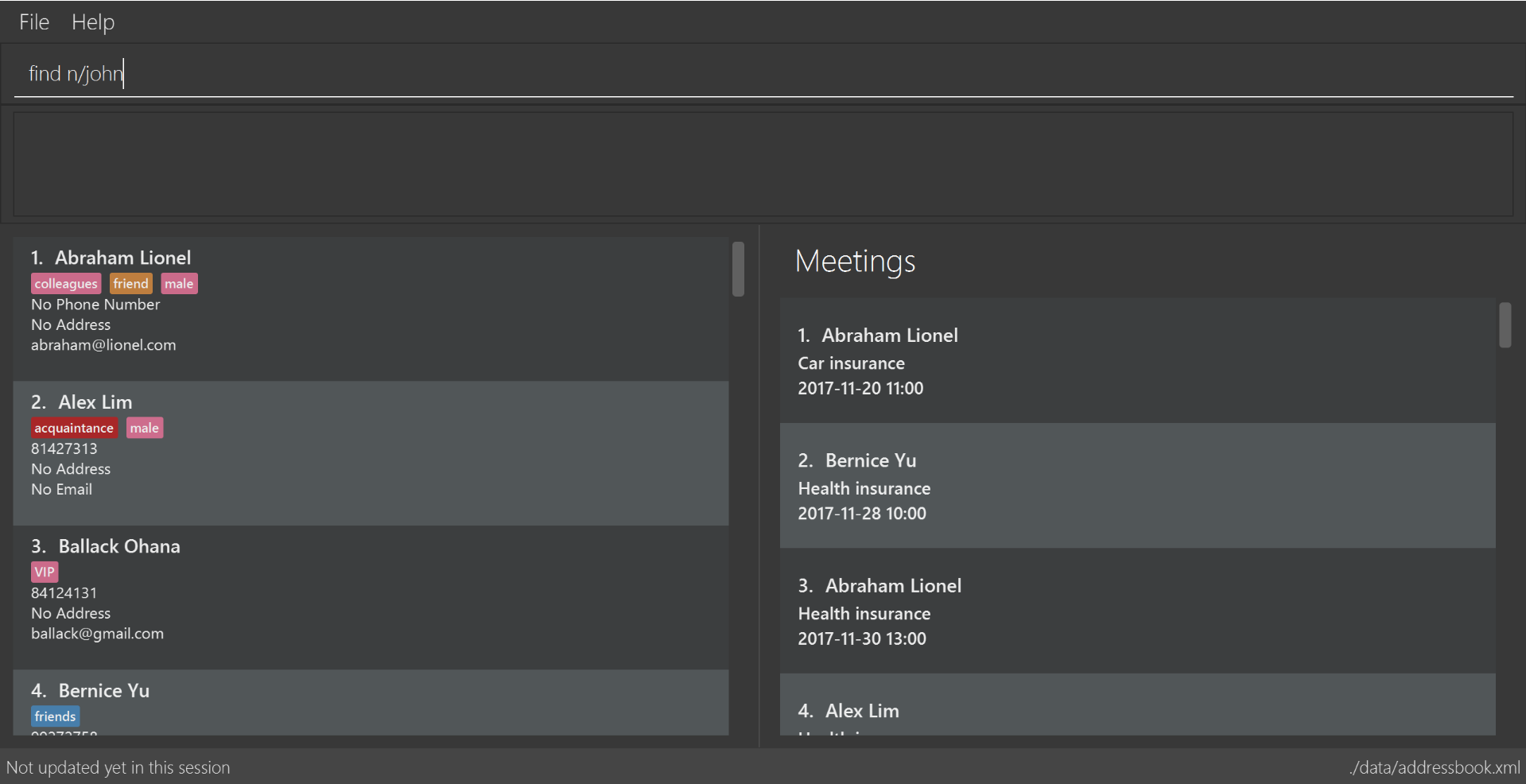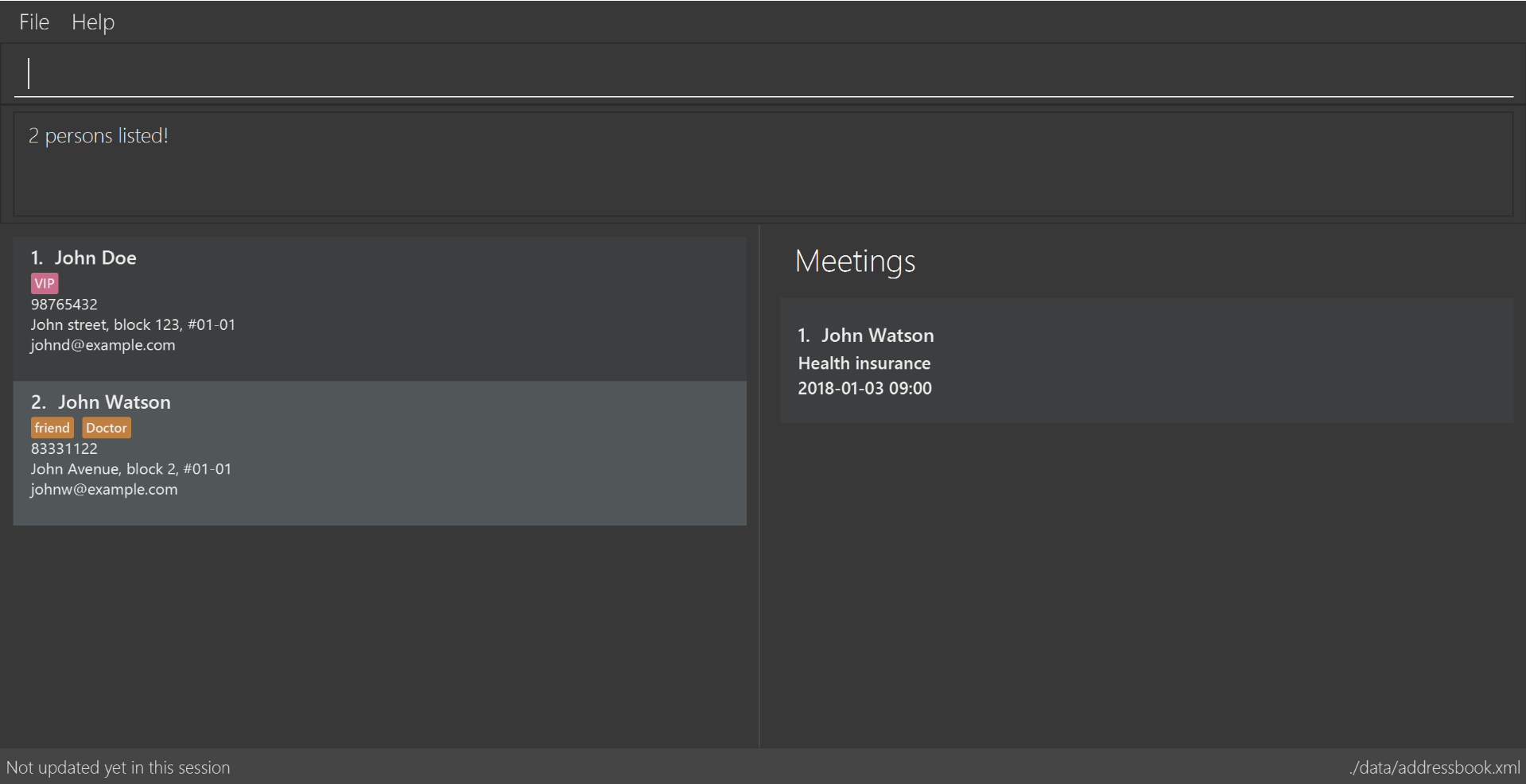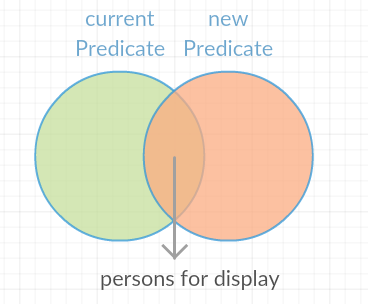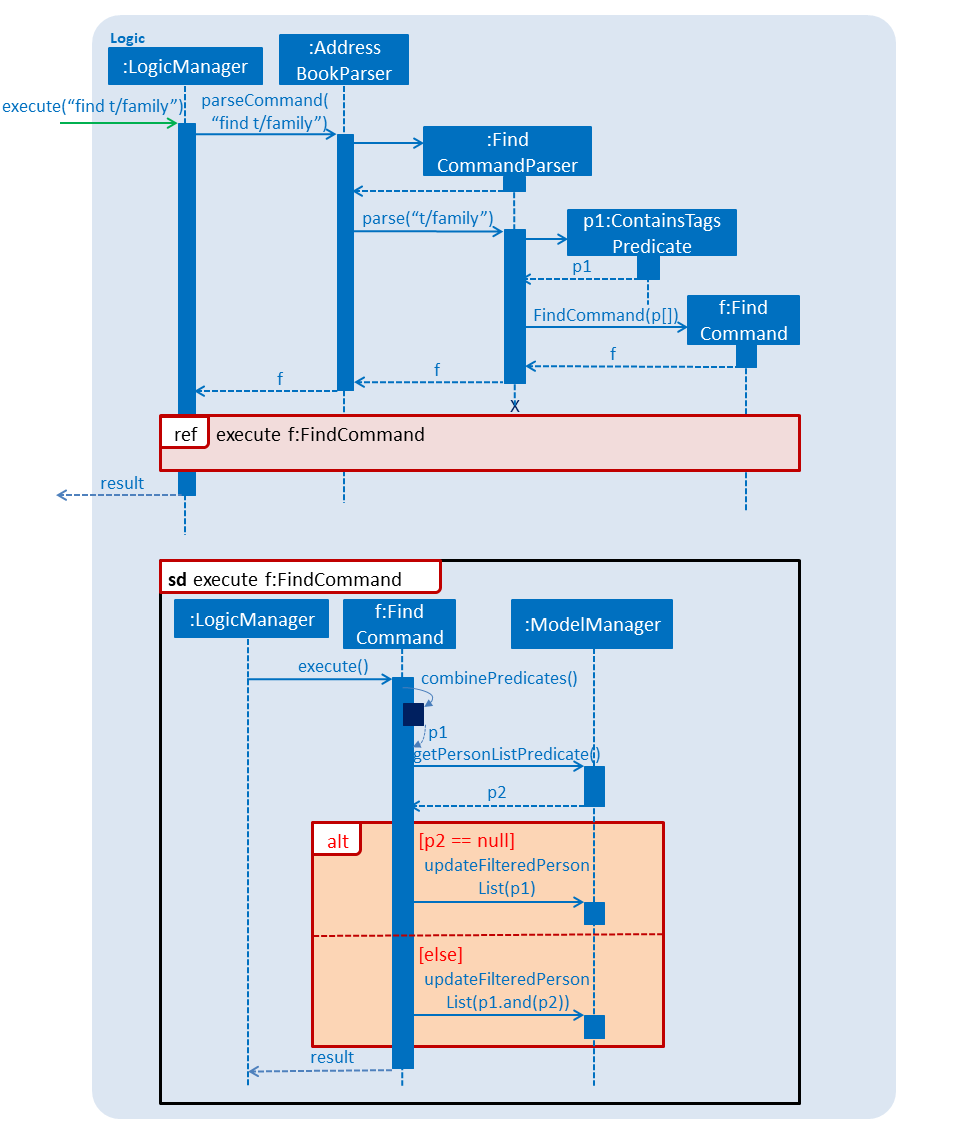Project: ABC Business Contacts
ABC Business Contacts is a free desktop contact management application that helps the user to manage a large collection of contacts conveniently and keep track of appointments. The user can store contacts as well as other information and retrieve them efficiently with the help of ABC.
The user interacts with it using a Command Line Interface(CLI), and it has a Graphic User Interface(GUI) created with JavaFX. It is written in Java, and has about 6 kLoC.
Code contributed: [Functional code] [Test code]
Locating persons by keywords: find
Command Name: find
Shorthand Alias: f
Function : Displays a filtered list of persons whose specified fields contain any of the given keywords
Format: find [n/KEYWORD…] [p/KEYWORD…] [e/KEYWORD…] [a/KEYWORD…] [t/KEYWORD…]
| There must be at least one argument |
If you want to find a person named John Watson:
-
Type in
>> find n/john
(See Figure 4.4.1)

Figure 4.4.1 -
Press Enter and you should see a list of persons having the name
john
(See Figure 4.4.2)

Figure 4.4.2
Here are some other ways you can use find:
-
>> find t/friends family p/88887777
Lists any person having tagsfriendsorfamilyor whose phone number is88887777. -
>> f e/*@example.com
Lists any person whose email domain isexample.com. -
>> find n/steph?n
Lists persons whose name isstephanorstephen.
End of Extract
Key Feature 1: Works on all fields
Justification
The new find command now works on all fields, i.e. Name, Phone Number, Email, Address and Tag. For example, the user can find a contact by phone numbers.
This allows the user to locate specific contacts efficiently using all available information on top of Name.
Key Feature 2: Allows wildcard symbols
Justification
Wildcard symbols * and ? are allowed in the parameters to match unknown symbols.
The use of wildcard symbols allows fuzzy search. It enables the user to search even if he forgets certain details.
The use of wildcard symbols also allows the user to search for a group of contacts sharing something similar. For example, the user can use *@example.com to search for contacts whose emails share the same domain.
Key Feature 3: Filters the displayed list
Justification
The find command filters the displayed list of contacts. Contacts not shown in the most recent listing would NOT show up in the result of a find command. Therefore, successive find commands would make the list smaller and smaller.
By filtering the displayed list, the user can narrow down the list to locate a specific contact without exact information or find a group of contacts sharing multiple similar properties.
Filtering mechanism in find
Basic mechanism
The list of persons displayed is filtered by a [Predicate]
when the method updateFilteredPersonList(predicate) from the Model interface is invoked.
The relevant methods in the Model interface are as follows:
public interface Model {
...
/** Returns the predicate of the current filtered person list */
Predicate<? super ReadOnlyPerson> getPersonListPredicate();
/** Updates the filter of the filtered person list to filter by the given {@code predicate}.*/
void updateFilteredPersonList(Predicate<ReadOnlyPerson> predicate);
}When updateFilteredPersonList(predicate) is invoked, every Person in ABC is evaluated against the predicate.
A Person is added to the displayed list if predicate.test(person) is evaluated to be TRUE.
Therefore, all Person instances that fulfill the conditions specified in predicate are displayed.
Filtering the displayed list
Note that all Person instances in the displayed list satisfy a Predicate currentPredicate. Given a new Predicate newPredicate, filtering the displayed list of contacts is equivalent to selecting Person instances that satisfy both currentPredicate and newPredicate. From Figure 3.4.2.1, it can also be viewed as the intersection of two lists of Person objects, each satisfying one of the two predicates respectively.

Figure 3.4.2.1 : Venn Diagram for Filtering
Implementation
The actual implementation of filtering the displayed list involves three steps.
-
Invoke
getPersonListPredicate()provided in the Model interface to get thecurrentPredicate. -
Use [Predicate.and()] to generated the logical AND of the two predicates.
-
Update the list using the predicate generated in step 2.
For more detail, refer to the sequence diagram(Figure 3.4.3.1) below.

Figure 3.4.3.1 : Sequence Diagram for Find
Design consideration
The design for filtering the displayed list applies the [Open/Close Principle].
-
By providing a new extension of
getPersonListPredicate()in theModelinterface, the new feature is enabled. -
By making use of the logical AND of two predicates, the list can be filtered without modification of the fundamental filtering mechanism.
End of Extract
Enhancement Added: Auto-Completion Suggestion
External behavior
Start of Extract [from: User Guide]
-
Suggestions will pop up for partial words keyed in. Press TAB to auto-complete using the first suggestion or press ↑↓ arrows and Enter to choose the suggestion.
End of Extract
Suggestions are also generated based on the context of what the user has keyed in. If the user is typing a command word, a list of valid command words would be generated. If the user is keying in tags, a list of valid tags from the stored contact data would be generated.
Justification
Auto-Completion allows users to type less. Moreover, since all suggestions are generated from the stored data, it can reduce the chance of mistyping. For example, if the user wants to find a contact by a very long name, the name would show up as a suggestion when the user type in the first few letters. On the other hand, if the user needs to type the name out in full, there is a higher chance for him to make mistakes.
Resizing the main window : resize
Command Name: resize
Shorthand Alias: rs
Function: Resizes the main window to the specified width and height in pixels
Format: resize WIDTH HEIGHT
Restriction on WIDTH and HEIGHT: 300 < = WIDTH < = width of the screen display, 230 < = HEIGHT < = height of the screen display
|
You CANNOT undo a resize command
|
If you want to resize your main window to 1280 * 720:
-
Type in
>> resize 1280 720
(See Figure 4.23.1)

Figure 4.23.1 -
Press Enter and the main window will be resized to 1280 * 720
End of Extract
Justification
The resize command allows the user to enlarge/shrink the size of the main window conveniently using CLI so that he can view more contacts or make space in the screen for other applications.
Enhancement Proposed: A More Powerful find Command
-
The user can choose to search from all contacts instead of the displayed ones using an argument
-awhich stands forall. For example,find -a t/friendswould search for ALL contacts that are tagged withfriends. -
The user can choose to search for contacts that satisfy all conditions using an argument
-swhich stands forstrict. For example,find -s n/John t/friendswould search for contacts that match BOTH the nameJohnthe tagfriends. -
The user can choose to filter away unwanted contacts from the displayed list using an argument
-uwhich stands forunwanted. For instance,find -u t/friendswould filter AWAY contacts tagged withfriends.
Enhancement Proposed: Rank Auto-Completion Suggestions by Occurrence
If a certain keyword is frequently used, it would show up first in the suggestion menu.
Other contributions
-
Discovered a bug that causes the app to crash and provided a solution. (Issue #137)
-
Discovered bugs during acceptance testing. (Issues #116, #117, #118)
-
Proposed wildcard symbol feature for reuse. (Issue #132)
-
Fixed a bug on undo/redo. (Pull Request #172)